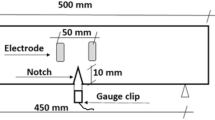Abstract
North American infrastructure, including steel bridges, are aging and reaching the end of their service lives. Over time, environmental stresses and cyclic truck traffic over bridges may lead to crack formation and crack propagation in the steel girders used in bridges. Cracks in steel girders decreases the load bearing capacity of the superstructure and may lead to failure of the structure. Existing methods of crack detection can not be practically deployed over larger structures. There is a need for a low-cost distributed crack sensing system. Given the critical nature of bridges, a continuous monitoring system would be preferred. Available continuous monitoring systems, such as Fiber Optic Sensors (FOS) are expensive which makes them unfeasible to be used for most of the bridges. In this paper, a new low-cost and accurate Binary sensor for detecting cracks in steel girders is discussed. The Binary sensor is comprised of wire bonded onto the girder using an adhesive. When the girder cracks, the crack is coupled to the wire, via the adhesive, causing it to also crack. The sensing system detects the open circuit in the wire created by the crack. A critical figure of merit for this system is the minimum crack width required to cause the wire to break. In the present work, cracks of less than 0.2 mm width can be reliably detected on steel girders.








Similar content being viewed by others
References
ISIS Canada (2004) ISIS canada educational module 5: an introduction to structural health monitoring
Feasibility of nondestructive crack detection and monitoring for steel bridges (2012) (FHWA-HRT-12-060)
Ghorbanpoor A, Benish N (2003) Wisconsin highway research program: non-destructive testing of wisconsin highway bridges. Wisconsin DOT, Milwaukee
Agdas D, Ice JA, Martinez JR, Lasa IR (2015) Comparison of visual inspection and structural-health monitoring as bridge condition assessment methods. J Perform Constr Facil 30(3). doi:10.1061/(ASCE)CF.1943-5509.0000802
McKeefry Jay A, Shield Carol K, (1999) Acoustic emission monitoring of fatigue cracks in steel bridge girders, DOT report number 1999-36. Minnesota Department of Transportation, Minnesota. Retrieved from the University of Minnesota Digital Conservancy. http://hdl.handle.net/11299/151796
Chang PC, Liu SC (2003) Recent research in nondestructive evaluation of civil infrastructures. Mater Civ Eng 15(June):298–304
Chajes M, Mertz D, Quiel S (2005) Steel girder fracture on Delaware’s I-95 bridge over the Brandywine River. In: Proc from struct congr 2005 Metrop Beyond, pp 1–10
Ellis R, Conner R (2013) Investigation and repair of the Diefenbaker Bridge fracture. Transportation Assosiation of Canada (Winnipeg)
Glisic B, Inaudi D (2011) Development of method for in-service crack detection based on distributed fiber optic sensors. Struct Heal Monit. doi:10.1177/1475921711414233
Zhang B et al (2013) Online bridge crack monitoring with smart film. doi:10.1155/2013/303656
Vishay Presicion Group (2015) Crack propagation patterns special use sensors—crack propagation sensors, Document number 11521
Yao Y, Glisic B (2015) Detection of steel fatigue cracks with strain sensing sheets based on large area electronics. Sensors 15(4):8088–8108
Sigurdardottir DH, Glisic B (2015) The neutral axis location for structural health monitoring: an overview. J Civil Struct Heal Monit 5(5):703–713
Plude S (2011) Implementing a long-term bridge monitoring strategy for a composite steel girder bridge, Dissertation. University of Connecticut
Ni YQ, Xia HW, Ye XW (2012) Neutral-axis position based damage detection of bridge deck using strain measurement: numerical and experimental verifications. In: 6th European workshop on structural health monitoring Dresden, Germany
Carden EP, Fanning P (2004) Vibration based condition monitoring: a review. Struct Heal Monit 3(4):355–377
Farrar CR, Darling TW, Migliori A, Baker WE (1999) Microwave interferometers for non-contact vibration measurements on large structures. Mech Syst Signal Process 13:241–253
Sohn H (2007) Effects of environmental and operational variability on structural health monitoring. Philos Trans R Soc 365(1851):539–560
Das S, Sasha P, Patro SK (2016) Vibration-based damage detection techniques used for health monitoring of structures: a review. J Civil Struct Heal Monit. doi:10.1007/s13349-016-0168-5
Cruz PJS, Salgado R (2008) Performance of vibration-based damage detection methods in bridges. Comput Civ Infrastruct Eng 24:62–79
Zhang B, Wang S, Li X, Zhang X, Yang G (2014) Crack width monitoring of concrete structures based on smart film. Smart Mater Struct. doi:10.1088/0964-1726/23/4/045031
Zhou Z, Zhang B, Xia K, Li X (2015) Smart film for crack monitoring of concrete bridges. Struct Heal Monit 10:275–289
Mufti A (2001) Guidelines for structural health monitoring. ISIS Canada Corporation, Winnipeg
Mufti A, Thomson D, Inaudi D, Vogel HM, McMahon D (2011) Crack detection of steel girders using Brillouin optical time domain analysis. J Civ Struct Heal Monit 1(3–4):61–68
Nishikawa M, Okabe T, Hemmi K, Takeda N (2008) Micromechanical modeling of the microbond test to quantify the interfacial properties of fiber-reinforced composites. Int J Solids Struct 45(14–15):4098–4113
Sockalingam S, Nilakantan G (2012) Fiber-Matrix interface characterization through the microbond test. Int J Aeronaut Space Sci 13(3):282–295
Raeisi F, Mufti A, Thomson DJ, Mustapha G (2015) Testing a binary crack sensor using a laboratory model of cracks in steel girders. In: The 5th international conference on smart materials and nanotechnology in engineering, Vancouver, Canada, 15–17 July 2015
Raeisi F, Mufti A, Saboktakin B, Thomson DJ, Mustapha G (2015) Crack detection in steel girders of bridges using a binary sensor. In: 7th International conference on structural health monitoring of intelligent infrastructure, Turin, Italy, 1–3 July 2015, p 229
Author information
Authors and Affiliations
Corresponding author
Rights and permissions
About this article
Cite this article
Raeisi, F., Mufti, A., Mustapha, G. et al. Crack detection in steel girders of bridges using a broken wire electronic binary sensor. J Civil Struct Health Monit 7, 233–243 (2017). https://doi.org/10.1007/s13349-017-0211-1
Received:
Revised:
Accepted:
Published:
Issue Date:
DOI: https://doi.org/10.1007/s13349-017-0211-1




